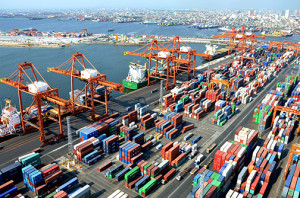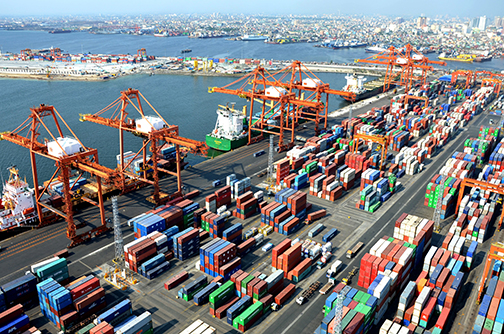 The government is looking at leasing a 10-hectare lot at the Cultural Center of the Philippines complex to house empty containers bound for Manila ports in a move to resolve port congestion.
The government is looking at leasing a 10-hectare lot at the Cultural Center of the Philippines complex to house empty containers bound for Manila ports in a move to resolve port congestion.
In a statement, Philippine Ports Authority (PPA) general manager Juan Sta. Ana said the Cabinet Cluster on Port Congestion (CCPC) is eyeing space at the CCP complex adjacent to the World Trade Center and behind the Philippine International Convention Center tent to serve as temporary holding area for empty containers bound for the Manila International Container Terminal (MICT) and Manila South Harbor (MSH).
PPA said government has started negotiations with the lot owners through a Department of Finance representative.
The facility will be operated by Manila port operators International Container Terminal Services, Inc. and Asian Terminals Inc, PPA said.
“Under this process, all empty containers from MICT and/or MSH will go directly to this facility and (there will be) no withdrawal of empties for export use in this facility. Such will be done using the existing process. To manage traffic, the port operators will dictate which time and date such empty containers will be accepted at the said facility,” the port agency said.
The potential lease of a depot forms part of a host of measures detailed by CCPC to bring yard utilization at Manila ports down to the more ideal 80% (from a high of 110% in May and June) in three to four months, PPA said, adding “significant changes” will be seen by August 15.
Suspension of Manila truck ban
If the August 15 target of “near-normal” port operations is not met, Trade Secretary Gregory Domingo said government may recommend the one-month suspension of the Manila truck ban, seen by many as the root cause of the port congestion.
At a forum held by the Federation of Philippine Industries last Friday, Domingo said, “By Aug. 15, conditions at the port should be close to normal. If not, we will revisit (the truck ban). If ever we recommend the lifting of the truck ban, we may first recommend that it be lifted for 30 days.”
But he said the goal already appeared attainable since the situation was “more than 50-percent resolved” as of Friday.
Subic as temporary depot
In the meantime, PPA is pushing for the use of ICTSI’s Subic New Container Terminals 1 and 2 as temporary depots for empty containers. The terminals, with a combined capacity of 600,000 twenty-foot-equivalent units, are offering to host empties free of charge, PPA said.
As it is, PortCalls sources said Maersk will move this month about 1,700 empty containers out of Manila to Subic. The empties will be loaded onto a new boxship commissioned by Maersk from Hanjin in Subic set to be turned over end of August.
ICTSI is also offering its 21-hectare property in Cabuyao, Laguna as another facility for housing empty boxes, with provision for a customs-bonded area for temporary transfer of cargoes yet to be cleared by the Bureau of Customs (BOC).
Another port decongestion measure outlined by CCPC is the increased utilization of the ports of Batangas and Subic.
PPA and other government agencies involved in trade, such as the Philippine Economic Zone Authority, are encouraging cargo owners to utilize Batangas port for southbound cargoes and Subic ports for northbound cargoes, instead of bringing them to Manila.
“Please note, however, that government is not forcing cargo owners to transfer their cargoes and shipping lines to call at these ports. Instead, it will still be their decision whether or not to use the two ports,” Sta. Ana said.
Carriers currently calling the Port of Batangas include MCC Transport, NYK, CMA CGM, SITC/Pacific International Lines and APL.
To encourage cargo owners to pull out their cargoes from Manila ports as soon as possible, “PPA is now contemplating reducing free storage of BOC-cleared cargoes at the three (Manila) ports. From the usual 5 days after the 45-day clearing period allowed by the BOC, the PPA is planning (to) reduce (this) and put a premium (in which) any cargo staying inside the port after free storage period after clearance will be levied a penalty of more than 3-fold of their existing fee for every day the cargo stays at the port.”
Earlier, PPA said it was eyeing higher penalties for cargo owners with overstaying cargoes at Manila ports. In addition the port agency said it would send “Customs-cleared and overstaying cargoes out of the Manila ports” with transportation of such cargo back to Manila paid for by cargo owners.
Meanwhile, one-fifth of the estimated 17,000 to 22,000 empty containers sitting at Manila ports have been removed by sweeper vessels of foreign shipping lines, PPA said. Three more sweepers are expected to arrive before August 15 to clear the rest, it added.
Sta. Ana said his agency is also advocating a scheme of trucking by appointment, in which “only trucks that will have business or cargo to be taken out of the port will be allowed inside the port for a specific time.” Likewise, empties to be deposited inside the port will follow this scheme.
Discounts for weekend release
To expedite port decongestion, PPA will give discounts on cargo-handling charges to cargo owners pulling out their shipments during weekends.
“The rationale behind this is to distribute about 25% of the daily cargo volume to be released on a weekend in order to further decongest the port and the roads,” Sta. Ana said.
The Federation of Filipino-Chinese Chambers of Commerce and Industry and the Confederation of Garment Manufacturers have agreed to maximize use of weekend cargo release until September in exchange for discounts on cargo-handling charges, PPA said.
Both groups ship about 1,000 containers a week.
PPA said the two have informed their members about their plan and are now coming up with a scheme to limit financial impact of the weekend release on operations. Warehouses of companies are usually closed during weekends to save on costs.
PPA said it is looking at striking a similar arrangement with the country’s top 100 corporations.
The agency is now bracing for a “second wave of port congestion”, as containers bound for the Philippines continue to pile up at the ports of Hong Kong, Singapore, and Kaohsiung in Taiwan.
Currently, a significant number of static containers are spread out at the three foreign ports, excluding those already in transit or set to be shipped out from other countries, PPA said. – Roumina Pablo
Photo courtesy of ICTSI





